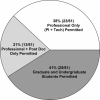Discovery and disclosure of incidental findings in neuroimaging research
- PMID: 15503329
- PMCID: PMC1506385
- DOI: 10.1002/jmri.20180
Discovery and disclosure of incidental findings in neuroimaging research
Abstract
Purpose: To examine different protocols for handling incidental findings on brain research MRIs, and provide a platform for establishing formal discussions of related ethical and policy issues.
Materials and methods: Corresponding authors identified from a database of peer-reviewed publications in 1991-2002 involving functional MRI (fMRI), alone or in combination with other imaging modalities, were invited to participate in this web-based survey. The survey asked questions regarding knowledge and handling of incidental findings, as well as characteristics of the scanning environment, training required, IRB protocol requirements, and neuroradiologist involvement.
Results: Seventy-four investigators who conduct MRI studies in the United States and abroad responded. Eighty-two percent (54/66) reported discovering incidental findings in their studies, such as arteriovenous malformations, brain tumors, and developmental abnormalities. Substantial variability was found in the procedures for handling and communicating findings to subjects, neuroradiologist involvement, personnel permitted to operate equipment, and training.
Conclusion: Guidelines for minimum and optimum standards for detecting and communicating incidental findings on brain MRI research are needed.
Figures


References
-
- Katzman GL, Dagher AP, Patronas NJ. Incidental findings on brain magnetic resonance imaging from 1000 asymptomatic volunteers. JAMA. 1999;282:36–39. - PubMed
-
- Illes J, Desmond JE, Huang LF, Raffin TA, Atlas SW. Ethical and practical considerations in managing incidental findings in functional magnetic resonance imaging. Brain Cogn. 2002;50:358–365. - PubMed
-
- Illes J, Kirschen MP, Gabrieli JD. From neuroimaging to neuroethics. Nat Neurosci. 2003;6:205. - PubMed
Publication types
MeSH terms
Grants and funding
LinkOut - more resources
Full Text Sources
Medical

